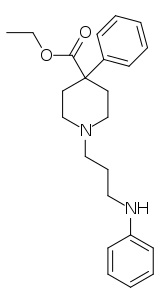Piminodine
Piminodine (Alvodine) is an opioid analgesic that is an analogue of pethidine (meperidine).[1] It was used in medicine briefly during the 1960s and 70s, but has largely fallen out of clinical use. It was used particularly for obstetric analgesia and in dental procedures and, like pethidine, could be combined with hydroxyzine to intensify the effects. The duration of action is 2 to 4 hours and 7.5 to 10 mg via the subcutaneous route is the most common starting dose, being equal to 80 to 100 mg of pethidine, 40 to 60 mg of alphaprodine and 10 mg of morphine. Oral formulations were also available.
 | |
| Clinical data | |
|---|---|
| ATC code |
|
| Identifiers | |
IUPAC name
| |
| CAS Number | |
| PubChem CID | |
| ChemSpider | |
| UNII | |
| CompTox Dashboard (EPA) | |
| ECHA InfoCard | 100.033.455 |
| Chemical and physical data | |
| Formula | C23H30N2O2 |
| Molar mass | 366.497 g/mol g·mol−1 |
| 3D model (JSmol) | |
SMILES
| |
InChI
| |
| | |
Piminodine has similar effects to other opioids, and produces analgesia, sedation and euphoria. Side effects can include itching, nausea and potentially serious respiratory depression which can be life-threatening.[2][3]
References
- Sim E, Dimoglo A, Shvets N, Ahsen V. Electronic-topological study of the structure-activity relationships in a series of piperidine morphinomimetics. Current Medicinal Chemistry. 2002 Aug;9(16):1537-45.
- Dekornfeld TJ, Lasagna L. The analgesic potency of piminodine (alvodine). Journal of Chronic Diseases. 1960 Aug;12:252-7.
- Woods LA, Deneau GA, Bennett DR, Domino EF, Seevers MH. A comparison of the pharmacology of two potent analgesic agents, piminodine (Win 14,098-2) and Win 13,797, with morphine and meperidine. Toxicology and Applied Pharmacology. 1961 May;3:358-79.